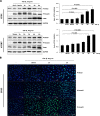Transforming growth factor-β (TGF-β)-mediated connective tissue growth factor (CTGF) expression in hepatic stellate cells requires Stat3 signaling activation
- PMID: 24005672
- PMCID: PMC3798541
- DOI: 10.1074/jbc.M113.478685
Transforming growth factor-β (TGF-β)-mediated connective tissue growth factor (CTGF) expression in hepatic stellate cells requires Stat3 signaling activation
Abstract
In fibrotic liver, connective tissue growth factor (CTGF) is constantly expressed in activated hepatic stellate cells (HSCs) and acts downstream of TGF-β to modulate extracellular matrix production. Distinct from other cell types in which Smad signaling plays major role in regulating CTGF production, TGF-β stimulated CTGF expression in activated HSCs is only in part dependent on Smad3. Other signaling molecules like MAPKs and PI3Ks may also participate in this process, and the underlying mechanisms have yet to be clarified. In this study, we report involvement of Stat3 activation in modulating CTGF production upon TGF-β challenge in activated HSCs. Stat3 is phosphorylated via JAK1 and acts as a critical ALK5 (activin receptor-like kinase 5) downstream signaling molecule to mediate CTGF expression. This process requires de novo gene transcription and is additionally modulated by MEK1/2, JNK, and PI3K pathways. Cell-specific knockdown of Smad3 partially decreases CTGF production, whereas it has no significant influence on Stat3 activation. The total CTGF production induced by TGF-β in activated HSCs is therefore, to a large extent, dependent on the balance and integration of the canonical Smad3 and Stat3 signaling pathways.
Keywords: ERK; Jak Kinase; Jun N-terminal Kinase (JNK); Liver Fibrosis; MAP Kinases (MAPKs); PI 3-kinase (PI3K); SMAD Transcription Factor.
Figures








Similar articles
-
Transforming growth factor β induces expression of connective tissue growth factor in hepatic progenitor cells through Smad independent signaling.Cell Signal. 2013 Oct;25(10):1981-92. doi: 10.1016/j.cellsig.2013.05.027. Epub 2013 May 28. Cell Signal. 2013. PMID: 23727026
-
IL-13 induces connective tissue growth factor in rat hepatic stellate cells via TGF-β-independent Smad signaling.J Immunol. 2011 Sep 1;187(5):2814-23. doi: 10.4049/jimmunol.1003260. Epub 2011 Jul 29. J Immunol. 2011. PMID: 21804025
-
Transforming Growth Factor-β (TGF-β) Directly Activates the JAK1-STAT3 Axis to Induce Hepatic Fibrosis in Coordination with the SMAD Pathway.J Biol Chem. 2017 Mar 10;292(10):4302-4312. doi: 10.1074/jbc.M116.773085. Epub 2017 Jan 31. J Biol Chem. 2017. PMID: 28154170 Free PMC article.
-
Regulation of hepatic stellate cells by connective tissue growth factor.Front Biosci (Landmark Ed). 2012 Jun 1;17(7):2495-507. doi: 10.2741/4067. Front Biosci (Landmark Ed). 2012. PMID: 22652794 Review.
-
Activation of Nrf2/AREs-mediated antioxidant signalling, and suppression of profibrotic TGF-β1/Smad3 pathway: a promising therapeutic strategy for hepatic fibrosis - A review.Life Sci. 2020 Sep 1;256:117909. doi: 10.1016/j.lfs.2020.117909. Epub 2020 Jun 5. Life Sci. 2020. PMID: 32512009 Review.
Cited by
-
Signaling molecules in the microenvironment of hepatocellular carcinoma.Funct Integr Genomics. 2024 Aug 29;24(5):146. doi: 10.1007/s10142-024-01427-7. Funct Integr Genomics. 2024. PMID: 39207523 Review.
-
TGFβ and Hippo Signaling Pathways Coordinate to Promote Acinar to Ductal Metaplasia in Human Pancreas.Cells. 2024 Jan 18;13(2):186. doi: 10.3390/cells13020186. Cells. 2024. PMID: 38247878 Free PMC article.
-
JAK/STAT pathway: Extracellular signals, diseases, immunity, and therapeutic regimens.Front Bioeng Biotechnol. 2023 Feb 23;11:1110765. doi: 10.3389/fbioe.2023.1110765. eCollection 2023. Front Bioeng Biotechnol. 2023. PMID: 36911202 Free PMC article. Review.
-
Embryonic organizer formation disorder leads to multiorgan dysplasia in Down syndrome.Cell Death Dis. 2022 Dec 19;13(12):1054. doi: 10.1038/s41419-022-05517-x. Cell Death Dis. 2022. PMID: 36535930 Free PMC article.
-
Src Inhibition Attenuates Liver Fibrosis by Preventing Hepatic Stellate Cell Activation and Decreasing Connetive Tissue Growth Factor.Cells. 2020 Feb 27;9(3):558. doi: 10.3390/cells9030558. Cells. 2020. PMID: 32120837 Free PMC article.
References
-
- Leask A., Abraham D. J. (2003) The role of connective tissue growth factor, a multifunctional matricellular protein, in fibroblast biology. Biochem. Cell Biol. 81, 355–363 - PubMed
-
- Gressner O. A., Gressner A. M. (2008) Connective tissue growth factor: a fibrogenic master switch in fibrotic liver diseases. Liver Int. 28, 1065–1079 - PubMed
-
- Williams E. J., Gaça M. D., Brigstock D. R., Arthur M. J., Benyon R. C. (2000) Increased expression of connective tissue growth factor in fibrotic human liver and in activated hepatic stellate cells. J. Hepatol. 32, 754–761 - PubMed
-
- Abou-Shady M., Friess H., Zimmermann A., di Mola F. F., Guo X. Z., Baer H. U., Büchler M. W. (2000) Connective tissue growth factor in human liver cirrhosis. Liver 20, 296–304 - PubMed
Publication types
MeSH terms
Substances
LinkOut - more resources
Full Text Sources
Other Literature Sources
Medical
Research Materials
Miscellaneous

